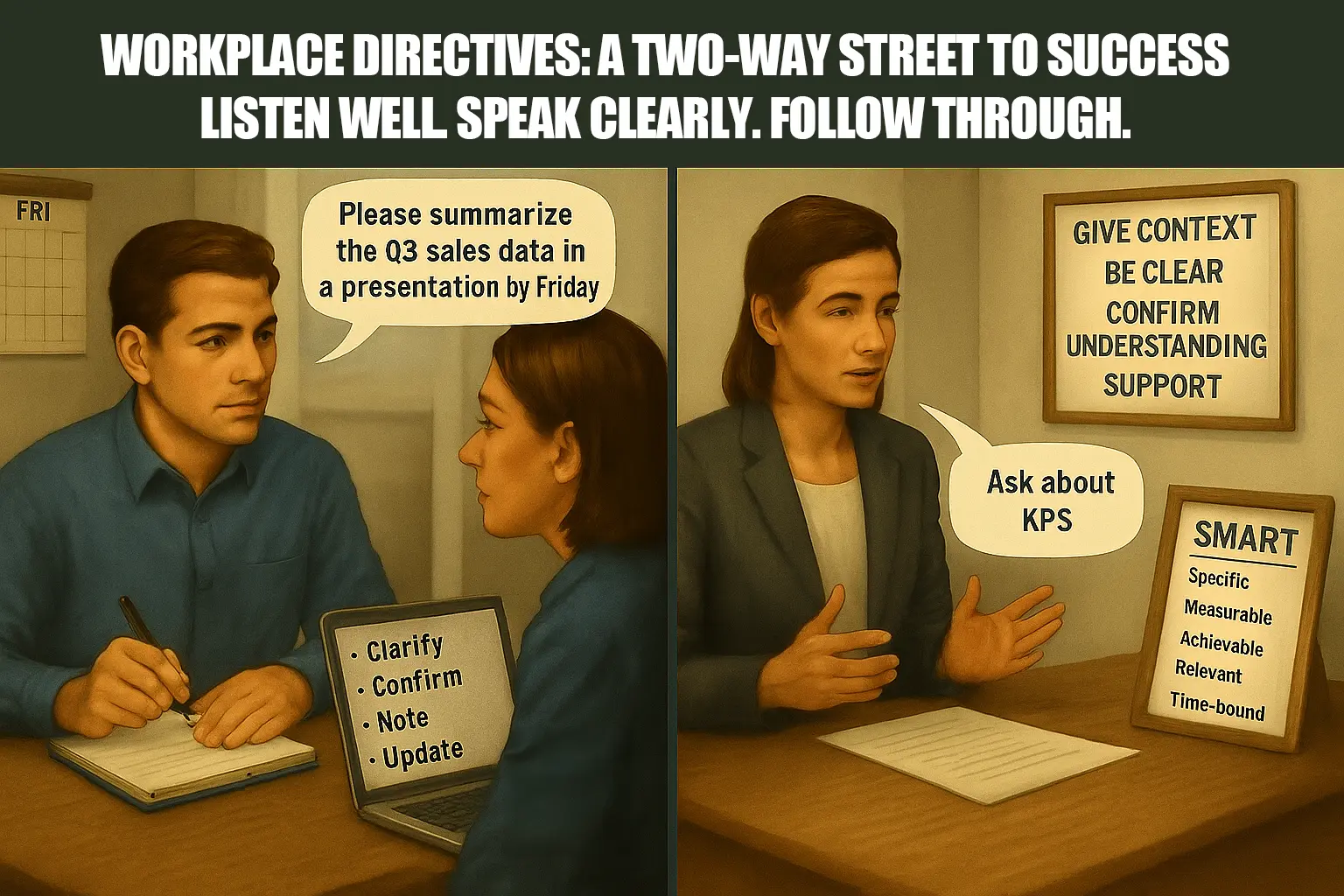Photo Copyright IQ INC.
In the intricate ecosystem of the modern workplace, the seamless flow of information is the lifeblood of productivity, innovation, and morale. At the heart of this informational exchange lies a fundamental yet often overlooked skill: the ability to both give and follow instructions effectively. This process, a delicate dance of communication between manager and employee, is fraught with potential for misunderstanding, leading to wasted time, costly errors, and strained professional relationships. A comprehensive analysis of a step-by-step approach to this critical interaction, coupled with an examination of common pitfalls, reveals a clear path toward a more efficient and harmonious work environment.
The Cornerstone of Execution: A Step-by-Step Guide to Following Instructions
The act of receiving and executing a work assignment is far more nuanced than simple obedience. It is an active process that demands engagement, critical thinking, and proactive communication. Mastering this skill is not a sign of subservience, but rather a hallmark of a reliable and detail-oriented professional.
Step 1: Active and Attentive Listening
The foundation of successfully following any instruction is to first fully comprehend it. This requires more than passively hearing the words spoken; it necessitates active listening. This means giving the instructor your undivided attention, minimizing distractions, and focusing on not just what is being said, but also the nuances of tone and body language. It is crucial to absorb the entirety of the directive before formulating questions or beginning the task.
Step 2: The Power of Clarifying Questions
Once the initial instruction has been delivered, the next critical step is to bridge any potential gaps in understanding. This is not a sign of incompetence, but of a diligent and proactive mindset. Well-phrased clarifying questions can unearth hidden assumptions and prevent future rework. Questions such as, “To ensure I’m on the right track, could you confirm that the primary goal is X?” or “What does a successful outcome look like to you?” can provide invaluable insight. Paraphrasing the instructions back to the giver—”So, just to confirm, you would like me to analyze the Q3 sales data to identify the top three performing regions and present my findings in a PowerPoint deck by Friday?”—is an excellent technique to ensure alignment.
Step 3: Meticulous Note-Taking
Human memory is fallible, especially when faced with multi-step or complex instructions. Relying on mental recall is a recipe for disaster. Therefore, the simple act of taking notes is a non-negotiable step. Whether in a physical notebook or a digital document, jotting down key deliverables, deadlines, and specific parameters creates a tangible record to refer back to. This practice not only aids the individual but also demonstrates a high level of organization and commitment to getting the job done right.
Step 4: Proactive Progress Updates
The period between receiving an instruction and completing the task should not be a black box of silence. Regular, concise progress updates are essential, particularly for longer-term projects. Informing the instructor of milestones reached, challenges encountered, and any necessary deviations from the original plan fosters transparency and allows for course correction if needed. A brief email or a quick chat can prevent small issues from escalating into major problems.
Step 5: Seeking Feedback and Embracing Iteration
Upon completion of the assignment, the final step is to present the work for review. This is not merely about seeking approval but about demonstrating accountability and a commitment to quality. Being open to constructive feedback and willing to make revisions is a sign of a growth mindset. This iterative process ensures that the final output meets or exceeds expectations and provides a valuable learning opportunity for future tasks.
The Architect of Action: A Step-by-Step Guide to Giving Instructions Effectively
The onus of clarity and success in work assignments lies heavily on the shoulders of the individual giving the instructions. A well-articulated directive can empower an employee and set them up for success, while a vague or incomplete instruction can lead to confusion, frustration, and subpar results.
Step 1: Prepare and Provide Context
Before approaching an employee with a task, a manager should have a clear vision of the desired outcome. This involves thinking through the specifics of the assignment and anticipating potential questions. Crucially, providing context is not a superfluous detail; it is a powerful motivator. Explaining the “why” behind a task—how it fits into the larger team or company goals—can significantly enhance an employee’s engagement and sense of purpose.
Step 2: Be Specific, Clear, and Concise
Vague language is the enemy of effective instruction. Ambiguous phrases like “as soon as possible” or “handle this” should be replaced with concrete details. Specify the exact deliverables, the required format, and the precise deadline. For instance, instead of saying, “Look into the customer complaints,” a more effective instruction would be, “Please analyze the customer complaints from the last quarter, categorize them by issue type, and provide a summary report by the end of the day on Thursday.” Using plain language and avoiding jargon, unless it is universally understood by the team, is also paramount.
Step 3: Set SMART Expectations
The SMART (Specific, Measurable, Achievable, Relevant, Time-bound) framework is an invaluable tool for setting clear expectations. This model forces the instructor to think through all the critical elements of an assignment. By defining what success looks like in measurable terms, both the manager and the employee have a shared understanding of the target.
Step 4: Encourage Questions and Confirm Understanding
After delivering the instructions, it is essential to create an environment where the employee feels comfortable asking for clarification. A simple, “What questions do you have for me?” can open the door for a productive dialogue. To further ensure comprehension, ask the employee to summarize the task in their own words. This “teach-back” method is a highly effective way to identify any misinterpretations before work commences.
Step 5: Provide Resources and Be Available for Support
A manager’s role does not end after the instructions have been given. It is their responsibility to ensure that the employee has the necessary resources—be it information, tools, or access to other team members—to complete the task successfully. Furthermore, remaining accessible for questions and offering support throughout the process demonstrates a commitment to the employee’s success and fosters a collaborative work environment.
Navigating the Minefield: Common Mistakes and How to Avoid Them
The path from instruction to execution is laden with potential missteps for both the giver and the receiver. Awareness of these common mistakes is the first step toward avoiding them.
Common Mistakes in Giving Instructions:
- Making Assumptions: Assuming an employee has prior knowledge or understands unstated expectations is a frequent error. Avoidance: Be explicit and spell everything out, even if it seems obvious.
- Information Overload: Bombarding an employee with too much information at once can be overwhelming and counterproductive. Avoidance: Break down complex tasks into smaller, manageable steps. Provide information in a logical sequence.
- Lack of a Feedback Loop: Failing to check for understanding and assuming silence equates to comprehension. Avoidance: Actively solicit questions and use the teach-back method.
- Micromanagement: Dictating every single step of the process can stifle creativity and autonomy. Avoidance: Focus on the “what” and the “why,” and allow the employee some autonomy in the “how,” where appropriate.
Common Mistakes in Following Instructions:
- Fear of Appearing Incompetent: Hesitation to ask questions for fear of looking foolish. Avoidance: Reframe asking questions as a sign of diligence and a commitment to accuracy.
- Making Unwarranted Assumptions: Filling in perceived gaps in the instructions with one’s own assumptions without verification. Avoidance: When in doubt, always ask for clarification.
- Failure to Take Notes: Overestimating one’s ability to remember details, leading to forgotten steps or incorrect information. Avoidance: Make note-taking a standard practice for every assignment.
- Lack of Communication During Execution: “Going dark” and not providing any updates, leaving the manager in the dark about progress and potential roadblocks. Avoidance: Establish a rhythm of regular, brief updates.
Conclusion: A Symphony of Shared Responsibility
Ultimately, the effective exchange of instructions is a shared responsibility that hinges on clear communication, mutual respect, and a collaborative spirit. It is a dynamic interplay that requires conscious effort from both the individual who assigns the task and the one who executes it. By adopting a step-by-step approach—from active listening and clarifying questions to providing context and encouraging feedback—organizations can foster a culture of clarity and accountability. Avoiding the common pitfalls of assumption and ambiguity transforms the instructional process from a potential source of conflict into a powerful driver of productivity and professional growth. Mastering this fundamental skill is not just about getting the work done; it is about building a foundation of trust and efficiency that will propel teams and individuals toward sustained success.
Click Here to Schedule a Consultation with Figeroux & Associates Today!



